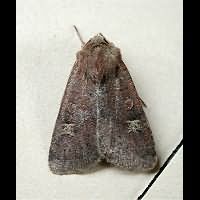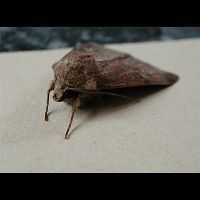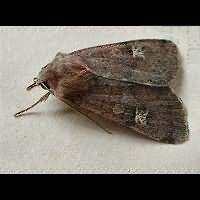Square-spot Rustic Xestia xanthographa
The Square-spot Rustic owes its name to the square (or trapezium shaped) spot in the front wing. It is the animal's kidney mark. This mark is found in many Noctuids and its presence or absence, shape and colouring are good aids in identifying a species. In this case the shape of the kidney mark makes it rather unmistakable. And that's a good thing, for further markings are vague or absent and the colour is highly variable. The basic colour runs from yellowish brown, through brown to blackish brown or even almost black. Very dark animals may be difficult to identify, though. Sometimes the shape of the kidneymark is invisible. The Square-spot Rustic has a wingspan ranging from 30 to 40 mm.
The eggs hatch in September. The caterpillars feed by night and hide by day. Half grown caterpillars overwinter, but in mild nights they are active. Apparently there is no real winter break. In May the larvae dig a small hole in the ground. In it they spin a fragile cocoon in which pupation takes place. Strangely enough, they do not pupate immediately, but remain inactive in their cocoon for 5 to 7 weeks. The caterpillars of the Square-spot Rustic are brownish. There is a light dorsal line running all over the back. This line has very dark edges. A similar line runs over the sides of the body. Adjacent to this line are small black spots at regular intervals. The caterpillar is darker above the lines on the sides and lighter below them. The caterpillars of the Square-spot Rustic and the Six-striped Rustic are identical and can not be told apart. The caterpillars reach a length of some 30 to 35 mm. We find them on grasses and other low vegetation usually, but also in birches and brambles.
The Square-spot Rustic is on the wing for a short time only: from late July to the beginning of September. They only fly by night, but are often seen on flowers such as hagworts and heather, even in small gardens. The animal can be tempted to visit your garden easily. Not only is it attracted to certain flowers, it is also attracted to light and sugar. Is easy to photograph when in a good spot, but often refuses to be handled. A very common and often numerous species all over the British Isles. Equally popular on the continent.
The Square-spot Rustic owes its name to the square (or trapezium shaped) spot in the front wing. It is the animal's kidney mark. This mark is found in many Noctuids and its presence or absence, shape and colouring are good aids in identifying a species. In this case the shape of the kidney mark makes it rather unmistakable. And that's a good thing, for further markings are vague or absent and the colour is highly variable. The basic colour runs from yellowish brown, through brown to blackish brown or even almost black. Very dark animals may be difficult to identify, though. Sometimes the shape of the kidneymark is invisible. The Square-spot Rustic has a wingspan ranging from 30 to 40 mm.
The eggs hatch in September. The caterpillars feed by night and hide by day. Half grown caterpillars overwinter, but in mild nights they are active. Apparently there is no real winter break. In May the larvae dig a small hole in the ground. In it they spin a fragile cocoon in which pupation takes place. Strangely enough, they do not pupate immediately, but remain inactive in their cocoon for 5 to 7 weeks. The caterpillars of the Square-spot Rustic are brownish. There is a light dorsal line running all over the back. This line has very dark edges. A similar line runs over the sides of the body. Adjacent to this line are small black spots at regular intervals. The caterpillar is darker above the lines on the sides and lighter below them. The caterpillars of the Square-spot Rustic and the Six-striped Rustic are identical and can not be told apart. The caterpillars reach a length of some 30 to 35 mm. We find them on grasses and other low vegetation usually, but also in birches and brambles.
The Square-spot Rustic is on the wing for a short time only: from late July to the beginning of September. They only fly by night, but are often seen on flowers such as hagworts and heather, even in small gardens. The animal can be tempted to visit your garden easily. Not only is it attracted to certain flowers, it is also attracted to light and sugar. Is easy to photograph when in a good spot, but often refuses to be handled. A very common and often numerous species all over the British Isles. Equally popular on the continent.






